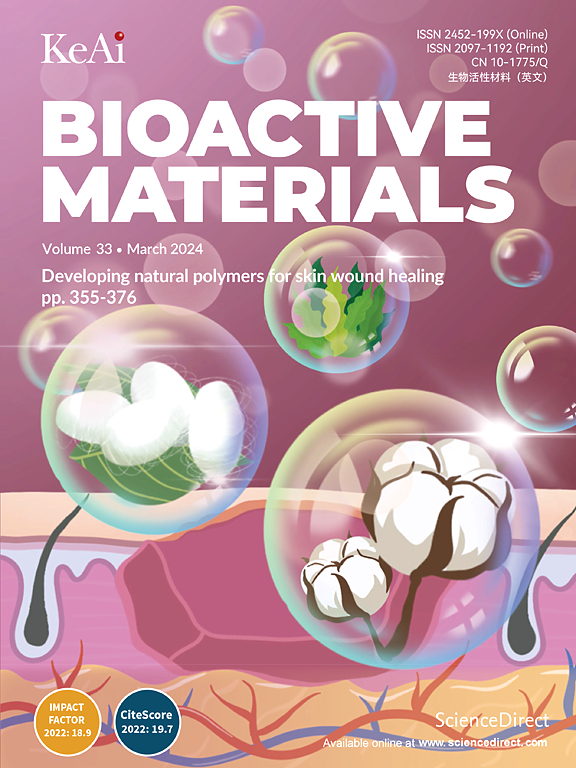对骨髓和脾脏具有双重调节作用的新型碳点作为治疗脊髓损伤的潜在候选药物。
IF 18
1区 医学
Q1 ENGINEERING, BIOMEDICAL
引用次数: 0
摘要
脊髓损伤触发白细胞从外周循环动员到损伤部位,加剧脊髓损伤。同时,骨髓造血干细胞(hsc)和脾白细胞迅速调动,补充耗尽的外周血白细胞池。然而,目前脊髓损伤的治疗忽视了针对外周免疫器官和组织的干预措施,这突出了开发能够有效调节外周免疫和治疗脊髓损伤的新型药物的必要性。在这项研究中,我们设计、合成并表征了新型阿胶碳点(EJCDs),它通过促进HSC自我更新来抑制髓细胞增殖和外周迁移,并在体外和体内明显分化为红系祖细胞。此外,EJCDs通过减少局部单核细胞和巨噬细胞的浸润,从而减弱脊髓损伤后脾脏(白细胞储存库)的免疫反应,同时促进运动功能恢复。这些作用是通过下调脾脏中CCAAT增强子结合蛋白-β的表达和上调骨髓中Lin- Sca-1+ c-kit+细胞(lsk)中FZD4蛋白的表达来介导的。我们的研究结果表明,EJCDs可以有效地减少脊髓损伤后的髓细胞浸润,促进神经系统恢复,使其成为治疗脊髓损伤的有希望的治疗候选药物。本文章由计算机程序翻译,如有差异,请以英文原文为准。

Novel carbon dots with dual Modulatory effects on the bone marrow and spleen as a potential therapeutic candidate for treating spinal cord injury
Spinal cord injury triggers leukocyte mobilization from the peripheral circulation to the injury site, exacerbating spinal cord damage. Simultaneously, bone marrow hematopoietic stem cells (HSCs) and splenic leukocytes rapidly mobilize to replenish the depleted peripheral blood leukocyte pool. However, current treatments for spinal cord injuries overlook interventions targeting peripheral immune organs and tissues, highlighting the need to develop novel drugs capable of effectively regulating peripheral immunity and treating spinal cord injuries. In this study, we designed, synthesized, and characterized novel Ejiao carbon dots (EJCDs) that inhibit myeloid cell proliferation and peripheral migration by promoting HSC self-renewal, and distinct differentiation into erythroid progenitors in vitro and in vivo. Additionally, EJCDs attenuate the immune response in the spleen, leukocytes’ reservoir, following spinal cord injury by diminishing the local infiltration of monocytes and macrophages while promoting motor function recovery. These effects are mediated through the downregulation of CCAAT enhancer binding protein-β expression in the spleen and the upregulation of FZD4 protein expression in Lin− Sca-1+ c-kit+ cells (LSKs) within the bone marrow. Our findings demonstrate that EJCDs effectively reduce myeloid cell infiltration post-spinal cord injury and promote neurological recovery, making them promising therapeutic candidates for treating spinal cord injuries.
求助全文
通过发布文献求助,成功后即可免费获取论文全文。
去求助
来源期刊

Bioactive Materials
Biochemistry, Genetics and Molecular Biology-Biotechnology
CiteScore
28.00
自引率
6.30%
发文量
436
审稿时长
20 days
期刊介绍:
Bioactive Materials is a peer-reviewed research publication that focuses on advancements in bioactive materials. The journal accepts research papers, reviews, and rapid communications in the field of next-generation biomaterials that interact with cells, tissues, and organs in various living organisms.
The primary goal of Bioactive Materials is to promote the science and engineering of biomaterials that exhibit adaptiveness to the biological environment. These materials are specifically designed to stimulate or direct appropriate cell and tissue responses or regulate interactions with microorganisms.
The journal covers a wide range of bioactive materials, including those that are engineered or designed in terms of their physical form (e.g. particulate, fiber), topology (e.g. porosity, surface roughness), or dimensions (ranging from macro to nano-scales). Contributions are sought from the following categories of bioactive materials:
Bioactive metals and alloys
Bioactive inorganics: ceramics, glasses, and carbon-based materials
Bioactive polymers and gels
Bioactive materials derived from natural sources
Bioactive composites
These materials find applications in human and veterinary medicine, such as implants, tissue engineering scaffolds, cell/drug/gene carriers, as well as imaging and sensing devices.
 求助内容:
求助内容: 应助结果提醒方式:
应助结果提醒方式:


